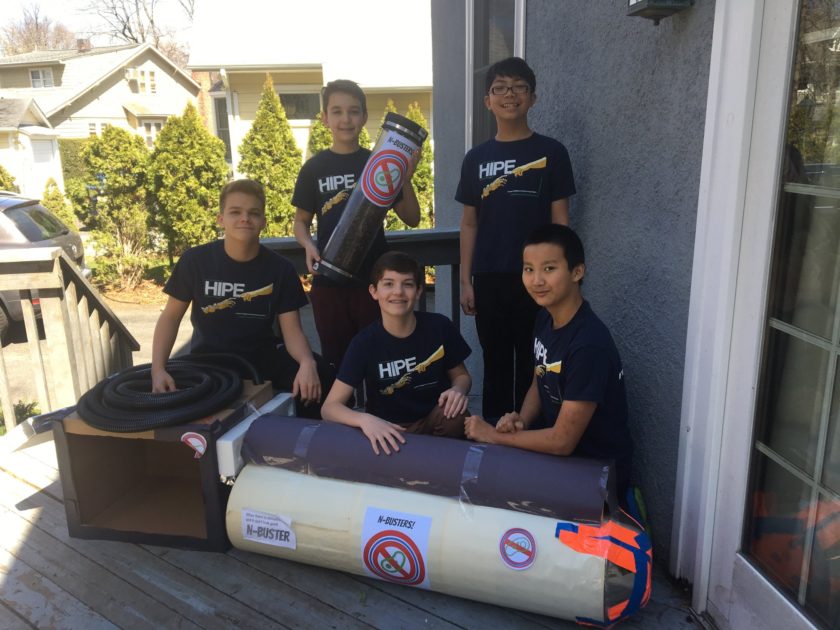
BERGEN COUNTY, N.J.—With several of New Jersey’s largest freshwater lakes and ponds closed most of the summer—due to harmful algal blooms caused by nutrient-rich stormwater runoff—an invention created and patented by five North Jersey teens to help prevent algal blooms could not be more timely.
Although the invention is not yet in full production, it did show promise enough, according to the teens, to get encouragement from Mahwah and Glen Rock environmental commissions, Bergen County Parks and the state Department of Environmental Protection.
In fact, Mahwah’s commission was hoping to propose the N-Buster for a Sustainable New Jersey grant effort, said one of the inventors.
“At first, the boys read about how beaver dams reduce nitrogen in waterways and thought, wow, this is a really novel idea. Then they read about scientists that created bioreactors for farms, which are somewhat the same thing and are successful.
“However, putting the device directly into rivers or streams to work on non-source-point nitrogen pollution (as opposed to point source, which is what is controlled on farms) is the novel element,” said Elaine Howe, mother of Alex Howe, one of the inventors.
Once it received its patent, Alex approached a Princeton University bioreactor researcher who allowed him to serve an internship over the summer and complete research on bioreactors similar to
N-Buster that also remove nitrogen.
“Reducing nitrates would have a direct effect on many of these [algal] blooms,” said Alex, a Glen Rock resident. He said his summerlong research on nitrogen with Dr. Bess Ward on similar bioreactors has application to the N-Buster.
He said the N-Buster, short for nitrogen buster, could likely last 15 years while removing nitrogen if maintained properly in a local waterway that feeds a pond or lake.
He said nitrogen removal rates depend on how many N-Buster devices are installed and the N-Busters can be customized to fit any lake or stream.
“It seems now to be a large scale problem that has garnered a lot of attention,” Howe said of algal-related closures.
He said he was “pleasantly surprised” that so much enthusiasm was expressed for potential tryout of the device “when I finalize my research on it.”
He said he hoped to reach out to a county parks representative to explore a demonstration of the invention. “We’re hoping it works out well” during demonstration, he added.
Device converts nitrogen
The teens invented a device that converts nitrogen found in water into nitrogen gas, which is safely released into the air and is not transmitted to other water bodies.
By releasing the nitrogen, a nutrient often found in storm runoff due to fertilizers used on lawns and landscapes, the device reduces a key ingredient that might otherwise help to trigger an algal bloom.
The N-Buster resembles an enclosed tube filled with wood chips with openings on either end.
The device slows water flow entering and contains naturally occurring bacteria to remove and release nitrogen from the water. It received a patent in November 2018.
The student-inventors, Alex Howe and Ethan Donovan of Glen Rock, Michael Yin of Ridgewood, Matt Harris of Hillsdale, and Jonathan Chin of Norwood, were friends who have worked on other science-based projects before putting their minds together to create N-Buster.

Summer of algal blooms
Since mid-June, the state Department of Environmental Protection has warned potential swimmers and boaters to avoid contact with most Lake Hopatcong waters due to widespread harmful blue-green algal blooms containing toxins. The DEP advised people not to eat fish caught in the lake and not to allow pets in the water.
So-called blue-green algal blooms create cyanotoxins that can be toxic to pets and humans have been found in more New Jersey lakes and ponds this year due to favorable conditions. This includes heavy rainfalls that carry nutrients into water bodies, extremely hot weather, stagnant water and low water oxygen levels, health officials note.
Blue-green algal blooms have been found in at least 12 lakes and reservoirs statewide since May, according to DEP, and July was ranked by the state climatologist as “unusually hot and wet.”
In late August, New York City officials confirmed the presence of cyanotoxins in Turtle Pond in Central Park and Prospect Park Lake and officials warned children and pets to stay away from them.
Toxic algae has already been responsible for the deaths of at least six dogs nationwide who have gotten ill after drinking contaminated water.
According to the state Department of Environmental Protection, cyanobacteria is often referred to as blue-green algae.
The bacteria “are not true algae but are capable of excessive growth through photosynthesis. Cyanobacteria blooms are usually a bright green” and can be confused for typical algae blooms.
A nonprofit water quality advocacy organization, Environmental Working Group, notes more than two-thirds of Americans use water drawn from rivers or lakes, and suppliers are struggling to keep nutrients and toxins out of water supplies.
They note warming temperatures, warmer water and bigger rainstorms can lead to formation of harmful algal blooms such as New Jersey’ widespread lake closures this summer.
Howe said by reducing the nutrient loads—specifically nitrogen—in storm runoff before it reaches the lakes and ponds, the N-Buster could be a factor in minimizing algal blooms.
Until its nitrogen-removal capacity is proven on a larger scale, however, it’s unlikely the invention will be used to help reduce algal blooms.
Doing research on a harmful algal bloom at Glen Rock’s Duck Pond in August 2018, team member Jonathan Chin came across research on beaver dams that were found to slow water and remove nitrogen.
Chin was doing research for a FIRST Lego League Competition and using his suggestion, the teen team was able to come up with a design that uses similar nitrogen-removal capacity in a smaller vessel for application to suburban streams and ponds.
Howe said her role on the team was to keep the boys organized and help them think critically about the issue in front of them.
“To that end, the boys read a lot about the issue and interviewed relevant experts. We met once a week during this process, everyone shared the research they had done over the week and then we would discuss what needed to be done next,” said Howe.
Due to a widespread outbreak of harmful algal blooms, the U.S. Environmental Protection Agency announced it has invited states to work with it and the U.S. agriculture department to help reduce nutrients in runoff, which often act as a catalyst to algal blooms.
Other suggestions by state authorities to remove nutrients include setting up stormwater utilities to better manage stormwater, upgrading septic systems or installing sanitary sewers, and figuring out how to better filter storm runoff to remove harmful toxins and nutrients.
Gov. Phil Murphy told reporters in late August the state will do a post-mortem “to figure out what we can do, and to make sure that we don’t have another summer that looks like that,” he said about widespread lake closures and health warnings to prevent contact with lake waters or consumption of fish.
Murphy acknowledged the massive economic impact of harmful algal blooms this summer, noting “enormous sympathy and empathy for the people that live on the lake [Hopatcong], particularly the commerce piece that has been impaired.”
An ocean of knowledge
Originally, said Elaine Howe, the teens developed N-Buster to help reduce ocean algal blooms, which were depleting oxygen and leaving so-called dead zones.
She added, “It is useful to remember that these blooms [lakes and ponds] are likely non-point source pollution. The Nitrogen Buster is designed to work in a stream or river.”
Nonpoint source pollution, also called polluted runoff, comes from storm runoff contaminated by road drippings, organic debris, pet and wastes, nutrients from lawns and landscapes, and toxic residues from automobiles.
In a background note on its patent application, the teen inventors point out the nationwide value of their invention in addressing nutrients in polluted runoff entering streams.
“In a memo dated Sep. 22, 2016, the disclosure of which is incorporated by reference in its entirety, the United States Environmental Protection Agency (EPA) notes that removing nutrient pollution from waterways is a national priority and cites issues such as Harmful Algae Blooms (HABs), as well as other types of algae blooms, found in an increasing number of waterways, as well as the presence of high nitrogen levels in certain drinking water sources.
“The EPA further notes that, Congress enacted the Harmful Algal Bloom and Hypoxia Research and Control Amendments Act in 2014, which extended the scope of the legislation to include the deployment of solutions to combat freshwater algae blooms and hypoxia,” states the patent application.
“The present invention addresses these and other problems by providing a unified, self-contained device that de-nitrifies the nutrient polluted water when deployed in [freshwater streams],” it adds.
